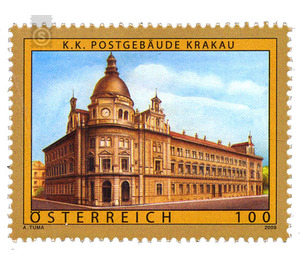Old Austria - Austria / II. Republic of Austria 2009 - 100 Euro Cent
Theme: Post & Philately
| Country | Austria / II. Republic of Austria |
| Issue Date | 2009 |
| Face Value | 100.00 |
| Edition Issued | 400,000 |
| Printing Type | offset |
| Stamp Type | Commemorative |
| Item Type | Stamp |
| Chronological Issue Number | 2127 |
| Chronological Chapter | OOS-OE2 |
| SID | 485402 |
| In 56 Wishlists | |
About 250 km south of the state capital Warsaw lies Krakow, the capital of the Lesser Poland Voivodeship. The old city, which until 1596 was the capital of Poland, is still called the secret capital of Poland. The Old Town and the Wawel, the former residence of the Polish kings, are UNESCO World Heritage Sites. Already 20,000 years ago, the Wawel Hill was settled, then salt was mined. In the fifth century Wislaner, a West Slavic tribe, settled around Krakow. It is believed that Kraków belonged to the Great Moravian Empire in the ninth century. Around 990 Krakow was conquered by Mieszko I and placed under the rule of the Polish Piast. Casimir I, the innovator, made Krakow the capital of Poland in 1038. Numerous Romanesque buildings were built during this period: the Wawel Rotunda, the churches of St. Adalbert and St. Andrew and the district of Okól. After tensions between the ecclesiastical and secular power Plotzk was declared the capital. Krakow took this place again at the beginning of the 12th century. The Krakow princes tried to reunite the Kingdom of Poland. At that time many Jews and Germans acquired the city right. Due to the invasion of the Tartars Krakow was destroyed in 1241 and had to be rebuilt. The salt mining was further promoted and brought the city to great wealth. In 1311 the Polish senior duke Wladyslaw Ellenlang had most of the Germans banished from the city, and some were even executed. More than a hundred years later, 36% of the inhabitants were German-speaking, and in the Marienkirche even German was preached. In the Middle Ages, many Polish-Austrian contacts came about through marriages of the ruling families. In 1515, connections between the Jagiellonians and the Habsburgs arose again at the Vienna Prince's Day. New contacts emerged in the common fight against the Turks in the 17th century under the Polish King John III. Sobieski. In 1795 Poland arrived in the course of the third division to the Habsburgs. A document on the establishment of a postal courier line from Krakow to Venice dated 18 October 1558 testifies to the long history of the Polish postal system.


